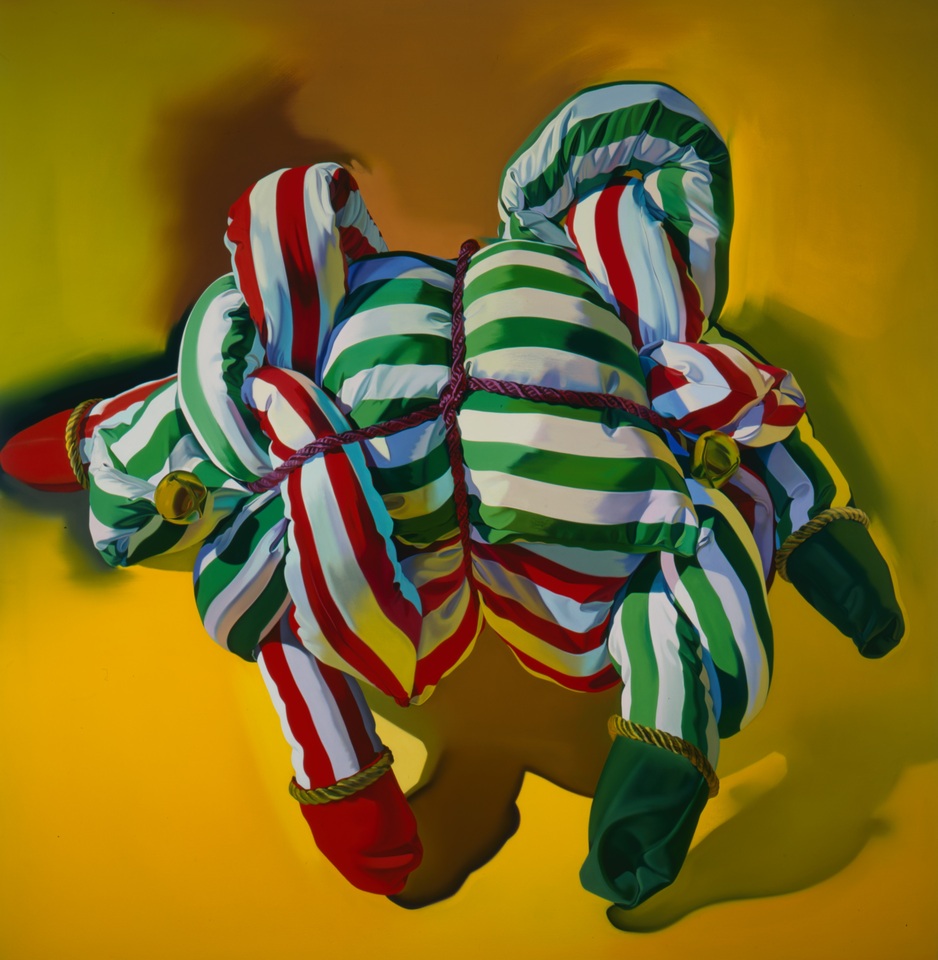It’s Hard to Be Happy
Orange County Museum of Art – 1998
by Bruce Guenther
The trajectory of our era will be remembered for its distinct focus on culture as its subject, everyday objects as its imagery foundation, and the struggles of a multicultural society to attain social identity as its focal point. Beginning in the late 1980s, the art world has underscored the exploration of collective identity and social concerns in response to the escalating intricacies of liberation policies and global economies that pervade daily life.
Official culture, during the 1980s, embraced minority voices like never before. Women, artists of color, and those whose “otherness” wasn’t immediately apparent, such as male and female homosexuals, were embraced by the avant-garde for creating art from their unique perspectives. Amid the avant-garde’s pursuit of a transgressive edge, validating “body” art and exploring gender identity spurred the first wave of openly homosexual art.
While Pop Art had appropriated pin-ups from girlie magazines to evoke the “swinging” associations of popular culture, homosexual artists ventured beyond, seeking images that revealed the underpinnings of Western culture and the complex relationship between sexuality and representation. Collaborating with feminist artists in deconstructing male heterosexual stereotypes, gay artists acknowledged the power of traditional gender-based signifiers in oppressing and manipulating the individual. Delving into the concrete physical and social constructs of daily life, their work exposed the heteronormative connotations of everyday objects. These artists argued that things often weren’t as they seemed and that they held deeper significance within a larger system of oppression or an unspoken subcultural marker. The social and political symbolism inherent in their work allowed emerging artists to challenge social perceptions and prejudices, while also expressing their sense of self without the traditional constraints that had obscured the contributions of women, people of color, and homosexuals.
By the mid- to late-1980s, the rise of minority voices within the mainstream American avant-garde created a validating environment in which artists like Brett Reichman could thrive. They developed an iconography of the “other” that would gain widespread acceptance. In Reichman’s paintings, the familiar and the exotic vie for attention. His studio and canvases are filled with objects from flea markets and art history alike.
Reichman stands out as one of the most captivating painters to emerge in the San Francisco Bay Area over the last decade. He presents a curious conundrum to the art world—a gay artist whose beautiful paintings, with their gay/camp subtext, delve into universal aspects of human nature.
Devoted to the flea market, Brett Reichman employs mass-produced remnants of consumer goods and children’s toys from the 1950s and 1960s as sources of imagery for his paintings. This imagery nurtures a complex dialogue of cultural critique and emotional revelation. Reichman recognizes the fetishistic quality of certain decorative objects and the deceptive innocence of childhood games and toys. Since 1990, he has woven a world of surfaces that paradoxically unveil the veneer of these tarnished artifacts of lost paradise. The rubber lambs and stuffed pixies of childhood, when merged with the Scyroco “gold” decorative fantasies of adulthood, transform into symbols of class, lost innocence, and sexual otherness.
Over the past eight years, Reichman has cultivated a striking portfolio that showcases the beauty within the absurd and reveals the sublime within camp. His paintings explore the nostalgia-laden, meaningless trinkets that fill the lives of the working class. They are triumphs of color, surface effects, and light. Reichman’s technical finesse produces a cool, self-effacing surface that juxtaposes against the volumes and colors of his compositions, evoking a mesmerizing beauty. The light and color in these recent oils are almost cinematic, as if the artist were adjusting the hue dial on a television monitor, intensifying shadows and highlights.
Reichman’s imagery abounds with suggestion and equivalence. A tangle of appendages and masses evokes physically and emotionally bound bodies, suggesting desire and restraint. These forms resonate with an undercurrent of desire, cautioning against submission. The provocative poses of the figures, marked by knowing vulnerability and subtly sinister implications, create a sense of unease in viewers. This aspect of the work is unmistakably homosexual, devoid of reference to the female, and darkly ribald in its humor. Reichman questions whether happiness is attainable in the era of AIDS, whether the unguarded openness of childhood remains viable in a perilous and violent age.
In Reichman’s most recent paintings, the elfin characters are present in residual form, through jaunty stripes and often phallic appendages. The cheerful striped fabric, reminiscent of thin, coarse flannel, evokes collective memories of simpler times. These objects are fabricated by the artist himself, their forms arising from hours of sewing and construction prior to being painted. Reichman’s works offer an intersection of the formal and the narrative, employing trompe l’oeil effects to seductive effect. The images suggest both universal and specific ideas, expressing the personal, the intuitive, and the physical in a way that resonates with diverse interpretations. As a gay artist, Reichman gives shape to issues of vulnerability and longing in a complex world, unleashing an emotional resonance. Through his archetypes and signifiers, the artist reveals something profound about the fleeting nature of youth, the elusive quality of desire, and the essential nature of love. His use of accessible references disarms a broad audience, providing a gateway to the more intricate and challenging gay and autobiographical dimensions of the work. The little elves, his unexpected alter egos, symbolize both the tenderness of childhood and the rawness of adulthood. Within this tension, Reichman voices the risks—both physical and emotional—of gay sexuality and the tension between security and passion.
